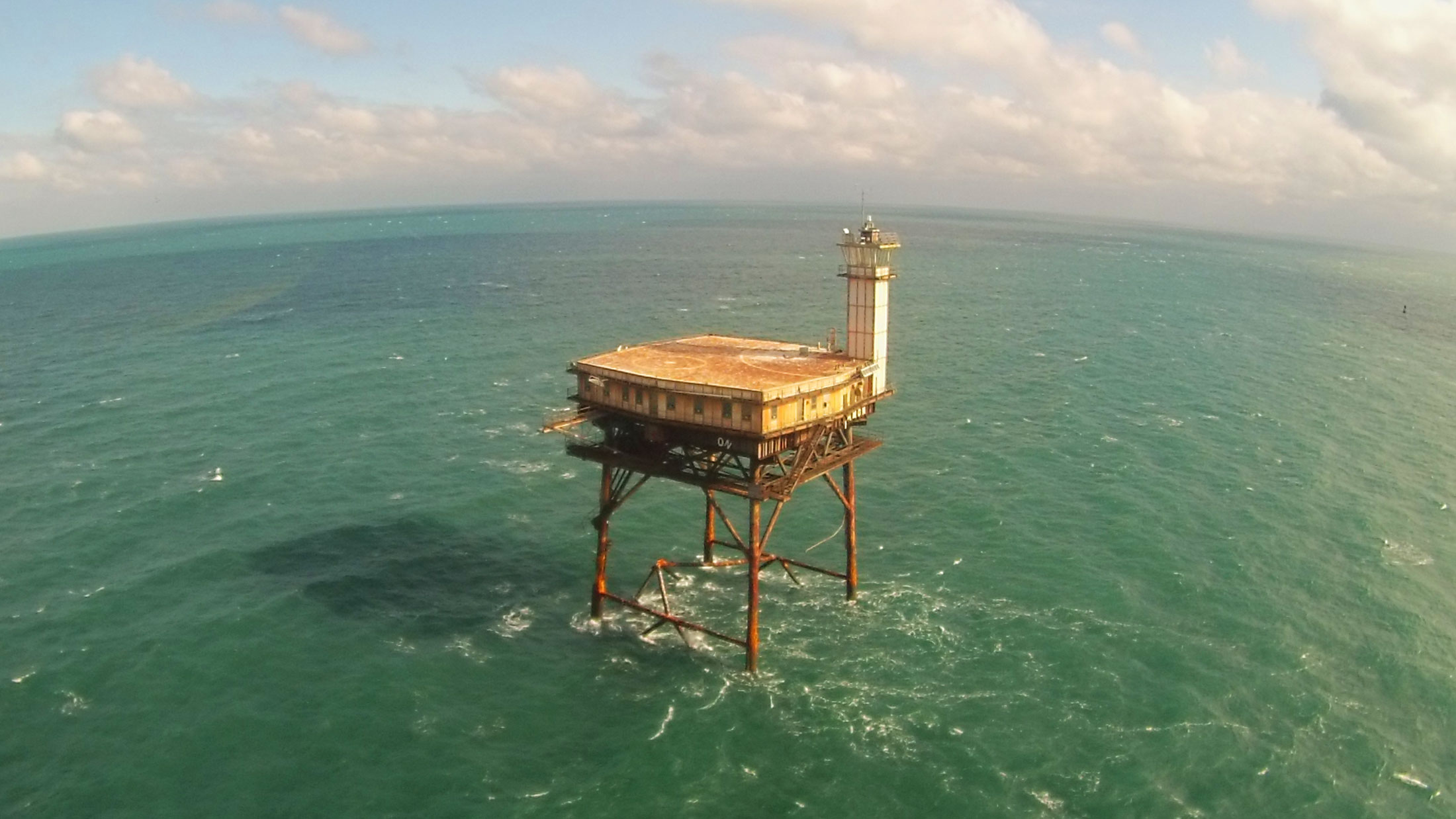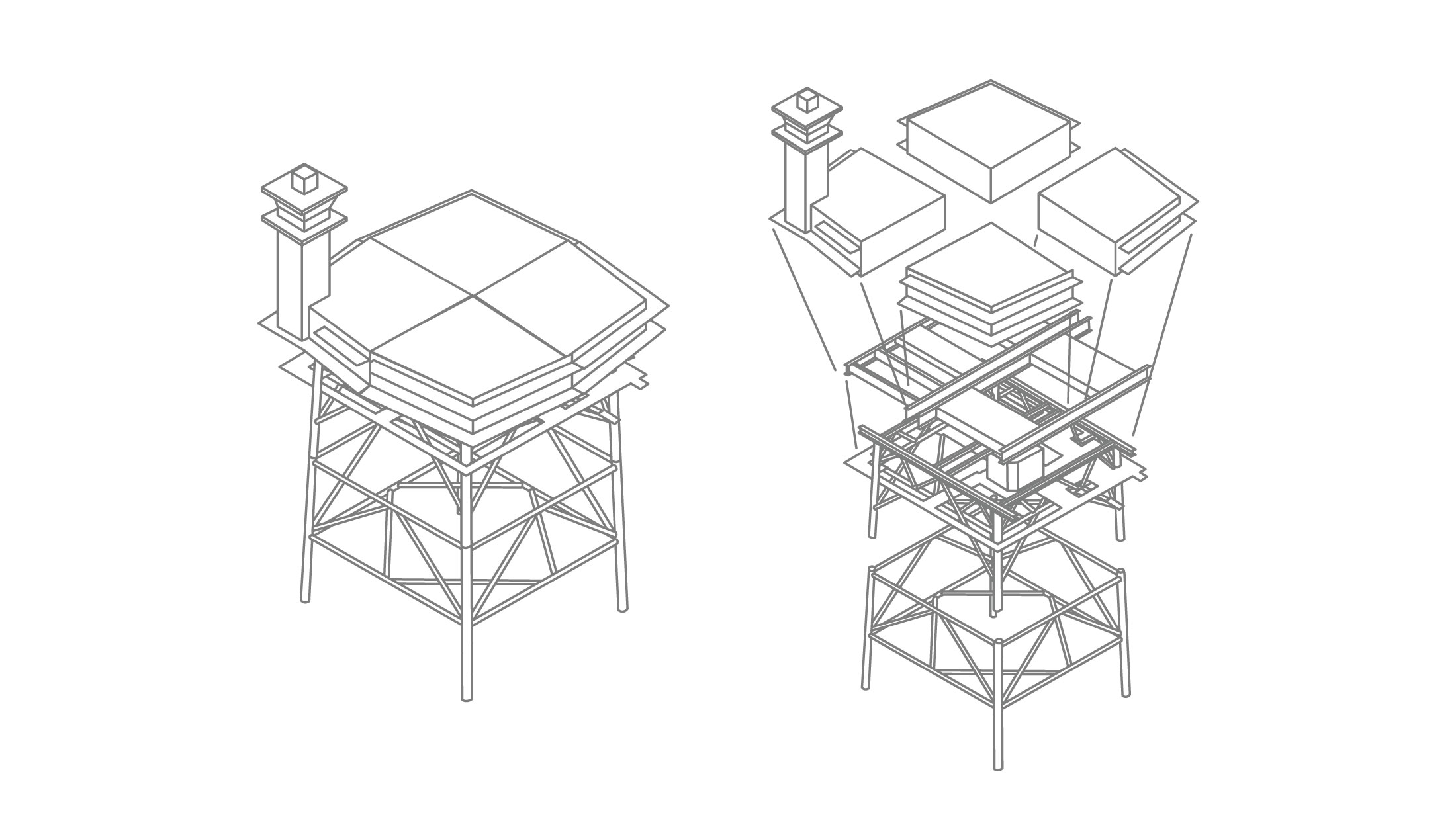The Diamond Shoals area of the Atlantic has always been a very dangerous navigational area for ships. Prior to the Light Station, light ships were used as navigational lights. The Diamond Shoal Light Station was put into service to save lives in 1966, acting as a manned Coast Guard station from 1966 until 1979. In 1979 the light was automated, without the need for a crew, and only periodically serviced by the coast guard. In 2001 the light was extinguished due to the widespread use of GPS. The station has been vacant since that time. The station was built on a “Texas Platform”. These structures were originally developed to be used for oil drilling platforms in deep water drilling environments, sometimes as deep as 200 – 300 feet. The station was erected in only 50 feet of water and its structural pylons are embedded more than 150 feet into the seabed. The island lighthouse station was put into service in 1966, acting as a manned Coast Guard station from 1966 until 1979. Replace client Dave Schneider bought the light station with hopes to one day turn it into a destination research facility. Replace worked to design an identity system for the station to give it a face and help with fund raising efforts. The Diamond Shoals logo mark plays with the shapes of diamonds to represent a gem emerging from a lump of coal and a light shining out of the darkness.
The Diamond Shoals area of the Atlantic has always been a very dangerous navigational area for ships. Prior to the Light Station, light ships were used as navigational lights. The Diamond Shoal Light Station was put into service to save lives in 1966, acting as a manned Coast Guard station from 1966 until 1979. In 1979 the light was automated, without the need for a crew, and only periodically serviced by the coast guard. In 2001 the light was extinguished due to the widespread use of GPS. The station has been vacant since that time. The station was built on a “Texas Platform”. These structures were originally developed to be used for oil drilling platforms in deep water drilling environments, sometimes as deep as 200 – 300 feet. The station was erected in only 50 feet of water and its structural pylons are embedded more than 150 feet into the seabed. The island lighthouse station was put into service in 1966, acting as a manned Coast Guard station from 1966 until 1979. Replace client Dave Schneider bought the light station with hopes to one day turn it into a destination research facility. Replace worked to design an identity system for the station to give it a face and help with fund raising efforts. The Diamond Shoals logo mark plays with the shapes of diamonds to represent a gem emerging from a lump of coal and a light shining out of the darkness.
The Diamond Shoals area of the Atlantic has always been a very dangerous navigational area for ships. Prior to the Light Station, light ships were used as navigational lights. The Diamond Shoal Light Station was put into service to save lives in 1966, acting as a manned Coast Guard station from 1966 until 1979. In 1979 the light was automated, without the need for a crew, and only periodically serviced by the coast guard. In 2001 the light was extinguished due to the widespread use of GPS. The station has been vacant since that time. The station was built on a “Texas Platform”. These structures were originally developed to be used for oil drilling platforms in deep water drilling environments, sometimes as deep as 200 – 300 feet. The station was erected in only 50 feet of water and its structural pylons are embedded more than 150 feet into the seabed. The island lighthouse station was put into service in 1966, acting as a manned Coast Guard station from 1966 until 1979. Replace client Dave Schneider bought the light station with hopes to one day turn it into a destination research facility. Replace worked to design an identity system for the station to give it a face and help with fund raising efforts. The Diamond Shoals logo mark plays with the shapes of diamonds to represent a gem emerging from a lump of coal and a light shining out of the darkness.
The Diamond Shoals area of the Atlantic has always been a very dangerous navigational area for ships. Prior to the Light Station, light ships were used as navigational lights. The Diamond Shoal Light Station was put into service to save lives in 1966, acting as a manned Coast Guard station from 1966 until 1979. In 1979 the light was automated, without the need for a crew, and only periodically serviced by the coast guard. In 2001 the light was extinguished due to the widespread use of GPS. The station has been vacant since that time. The station was built on a “Texas Platform”. These structures were originally developed to be used for oil drilling platforms in deep water drilling environments, sometimes as deep as 200 – 300 feet. The station was erected in only 50 feet of water and its structural pylons are embedded more than 150 feet into the seabed. The island lighthouse station was put into service in 1966, acting as a manned Coast Guard station from 1966 until 1979. Replace client Dave Schneider bought the light station with hopes to one day turn it into a destination research facility. Replace worked to design an identity system for the station to give it a face and help with fund raising efforts. The Diamond Shoals logo mark plays with the shapes of diamonds to represent a gem emerging from a lump of coal and a light shining out of the darkness.
The Diamond Shoals area of the Atlantic has always been a very dangerous navigational area for ships. Prior to the Light Station, light ships were used as navigational lights. The Diamond Shoal Light Station was put into service to save lives in 1966, acting as a manned Coast Guard station from 1966 until 1979. In 1979 the light was automated, without the need for a crew, and only periodically serviced by the coast guard. In 2001 the light was extinguished due to the widespread use of GPS. The station has been vacant since that time. The station was built on a “Texas Platform”. These structures were originally developed to be used for oil drilling platforms in deep water drilling environments, sometimes as deep as 200 – 300 feet. The station was erected in only 50 feet of water and its structural pylons are embedded more than 150 feet into the seabed. The island lighthouse station was put into service in 1966, acting as a manned Coast Guard station from 1966 until 1979. Replace client Dave Schneider bought the light station with hopes to one day turn it into a destination research facility. Replace worked to design an identity system for the station to give it a face and help with fund raising efforts. The Diamond Shoals logo mark plays with the shapes of diamonds to represent a gem emerging from a lump of coal and a light shining out of the darkness.
The Diamond Shoals area of the Atlantic has always been a very dangerous navigational area for ships. Prior to the Light Station, light ships were used as navigational lights. The Diamond Shoal Light Station was put into service to save lives in 1966, acting as a manned Coast Guard station from 1966 until 1979. In 1979 the light was automated, without the need for a crew, and only periodically serviced by the coast guard. In 2001 the light was extinguished due to the widespread use of GPS. The station has been vacant since that time. The station was built on a “Texas Platform”. These structures were originally developed to be used for oil drilling platforms in deep water drilling environments, sometimes as deep as 200 – 300 feet. The station was erected in only 50 feet of water and its structural pylons are embedded more than 150 feet into the seabed. The island lighthouse station was put into service in 1966, acting as a manned Coast Guard station from 1966 until 1979. Replace client Dave Schneider bought the light station with hopes to one day turn it into a destination research facility. Replace worked to design an identity system for the station to give it a face and help with fund raising efforts. The Diamond Shoals logo mark plays with the shapes of diamonds to represent a gem emerging from a lump of coal and a light shining out of the darkness.
The Diamond Shoals area of the Atlantic has always been a very dangerous navigational area for ships. Prior to the Light Station, light ships were used as navigational lights. The Diamond Shoal Light Station was put into service to save lives in 1966, acting as a manned Coast Guard station from 1966 until 1979. In 1979 the light was automated, without the need for a crew, and only periodically serviced by the coast guard. In 2001 the light was extinguished due to the widespread use of GPS. The station has been vacant since that time. The station was built on a “Texas Platform”. These structures were originally developed to be used for oil drilling platforms in deep water drilling environments, sometimes as deep as 200 – 300 feet. The station was erected in only 50 feet of water and its structural pylons are embedded more than 150 feet into the seabed. The island lighthouse station was put into service in 1966, acting as a manned Coast Guard station from 1966 until 1979. Replace client Dave Schneider bought the light station with hopes to one day turn it into a destination research facility. Replace worked to design an identity system for the station to give it a face and help with fund raising efforts. The Diamond Shoals logo mark plays with the shapes of diamonds to represent a gem emerging from a lump of coal and a light shining out of the darkness.
The Diamond Shoals area of the Atlantic has always been a very dangerous navigational area for ships. Prior to the Light Station, light ships were used as navigational lights. The Diamond Shoal Light Station was put into service to save lives in 1966, acting as a manned Coast Guard station from 1966 until 1979. In 1979 the light was automated, without the need for a crew, and only periodically serviced by the coast guard. In 2001 the light was extinguished due to the widespread use of GPS. The station has been vacant since that time. The station was built on a “Texas Platform”. These structures were originally developed to be used for oil drilling platforms in deep water drilling environments, sometimes as deep as 200 – 300 feet. The station was erected in only 50 feet of water and its structural pylons are embedded more than 150 feet into the seabed. The island lighthouse station was put into service in 1966, acting as a manned Coast Guard station from 1966 until 1979. Replace client Dave Schneider bought the light station with hopes to one day turn it into a destination research facility. Replace worked to design an identity system for the station to give it a face and help with fund raising efforts. The Diamond Shoals logo mark plays with the shapes of diamonds to represent a gem emerging from a lump of coal and a light shining out of the darkness.
The Diamond Shoals area of the Atlantic has always been a very dangerous navigational area for ships. Prior to the Light Station, light ships were used as navigational lights. The Diamond Shoal Light Station was put into service to save lives in 1966, acting as a manned Coast Guard station from 1966 until 1979. In 1979 the light was automated, without the need for a crew, and only periodically serviced by the coast guard. In 2001 the light was extinguished due to the widespread use of GPS. The station has been vacant since that time. The station was built on a “Texas Platform”. These structures were originally developed to be used for oil drilling platforms in deep water drilling environments, sometimes as deep as 200 – 300 feet. The station was erected in only 50 feet of water and its structural pylons are embedded more than 150 feet into the seabed. The island lighthouse station was put into service in 1966, acting as a manned Coast Guard station from 1966 until 1979. Replace client Dave Schneider bought the light station with hopes to one day turn it into a destination research facility. Replace worked to design an identity system for the station to give it a face and help with fund raising efforts. The Diamond Shoals logo mark plays with the shapes of diamonds to represent a gem emerging from a lump of coal and a light shining out of the darkness.
The Diamond Shoals area of the Atlantic has always been a very dangerous navigational area for ships. Prior to the Light Station, light ships were used as navigational lights. The Diamond Shoal Light Station was put into service to save lives in 1966, acting as a manned Coast Guard station from 1966 until 1979. In 1979 the light was automated, without the need for a crew, and only periodically serviced by the coast guard. In 2001 the light was extinguished due to the widespread use of GPS. The station has been vacant since that time. The station was built on a “Texas Platform”. These structures were originally developed to be used for oil drilling platforms in deep water drilling environments, sometimes as deep as 200 – 300 feet. The station was erected in only 50 feet of water and its structural pylons are embedded more than 150 feet into the seabed. The island lighthouse station was put into service in 1966, acting as a manned Coast Guard station from 1966 until 1979. Replace client Dave Schneider bought the light station with hopes to one day turn it into a destination research facility. Replace worked to design an identity system for the station to give it a face and help with fund raising efforts. The Diamond Shoals logo mark plays with the shapes of diamonds to represent a gem emerging from a lump of coal and a light shining out of the darkness.
The Diamond Shoals area of the Atlantic has always been a very dangerous navigational area for ships. Prior to the Light Station, light ships were used as navigational lights. The Diamond Shoal Light Station was put into service to save lives in 1966, acting as a manned Coast Guard station from 1966 until 1979. In 1979 the light was automated, without the need for a crew, and only periodically serviced by the coast guard. In 2001 the light was extinguished due to the widespread use of GPS. The station has been vacant since that time. The station was built on a “Texas Platform”. These structures were originally developed to be used for oil drilling platforms in deep water drilling environments, sometimes as deep as 200 – 300 feet. The station was erected in only 50 feet of water and its structural pylons are embedded more than 150 feet into the seabed. The island lighthouse station was put into service in 1966, acting as a manned Coast Guard station from 1966 until 1979. Replace client Dave Schneider bought the light station with hopes to one day turn it into a destination research facility. Replace worked to design an identity system for the station to give it a face and help with fund raising efforts. The Diamond Shoals logo mark plays with the shapes of diamonds to represent a gem emerging from a lump of coal and a light shining out of the darkness.
The Diamond Shoals area of the Atlantic has always been a very dangerous navigational area for ships. Prior to the Light Station, light ships were used as navigational lights. The Diamond Shoal Light Station was put into service to save lives in 1966, acting as a manned Coast Guard station from 1966 until 1979. In 1979 the light was automated, without the need for a crew, and only periodically serviced by the coast guard. In 2001 the light was extinguished due to the widespread use of GPS. The station has been vacant since that time. The station was built on a “Texas Platform”. These structures were originally developed to be used for oil drilling platforms in deep water drilling environments, sometimes as deep as 200 – 300 feet. The station was erected in only 50 feet of water and its structural pylons are embedded more than 150 feet into the seabed. The island lighthouse station was put into service in 1966, acting as a manned Coast Guard station from 1966 until 1979. Replace client Dave Schneider bought the light station with hopes to one day turn it into a destination research facility. Replace worked to design an identity system for the station to give it a face and help with fund raising efforts. The Diamond Shoals logo mark plays with the shapes of diamonds to represent a gem emerging from a lump of coal and a light shining out of the darkness.
The Diamond Shoals area of the Atlantic has always been a very dangerous navigational area for ships. Prior to the Light Station, light ships were used as navigational lights. The Diamond Shoal Light Station was put into service to save lives in 1966, acting as a manned Coast Guard station from 1966 until 1979. In 1979 the light was automated, without the need for a crew, and only periodically serviced by the coast guard. In 2001 the light was extinguished due to the widespread use of GPS. The station has been vacant since that time. The station was built on a “Texas Platform”. These structures were originally developed to be used for oil drilling platforms in deep water drilling environments, sometimes as deep as 200 – 300 feet. The station was erected in only 50 feet of water and its structural pylons are embedded more than 150 feet into the seabed. The island lighthouse station was put into service in 1966, acting as a manned Coast Guard station from 1966 until 1979. Replace client Dave Schneider bought the light station with hopes to one day turn it into a destination research facility. Replace worked to design an identity system for the station to give it a face and help with fund raising efforts. The Diamond Shoals logo mark plays with the shapes of diamonds to represent a gem emerging from a lump of coal and a light shining out of the darkness.
The Diamond Shoals area of the Atlantic has always been a very dangerous navigational area for ships. Prior to the Light Station, light ships were used as navigational lights. The Diamond Shoal Light Station was put into service to save lives in 1966, acting as a manned Coast Guard station from 1966 until 1979. In 1979 the light was automated, without the need for a crew, and only periodically serviced by the coast guard. In 2001 the light was extinguished due to the widespread use of GPS. The station has been vacant since that time. The station was built on a “Texas Platform”. These structures were originally developed to be used for oil drilling platforms in deep water drilling environments, sometimes as deep as 200 – 300 feet. The station was erected in only 50 feet of water and its structural pylons are embedded more than 150 feet into the seabed. The island lighthouse station was put into service in 1966, acting as a manned Coast Guard station from 1966 until 1979. Replace client Dave Schneider bought the light station with hopes to one day turn it into a destination research facility. Replace worked to design an identity system for the station to give it a face and help with fund raising efforts. The Diamond Shoals logo mark plays with the shapes of diamonds to represent a gem emerging from a lump of coal and a light shining out of the darkness.











